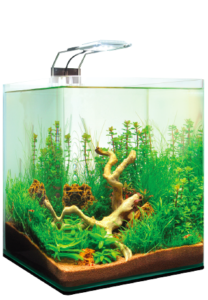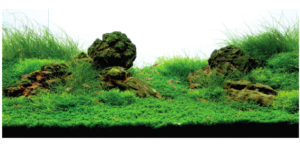There has been much interest in the planted aquarium as more and more hobbyists discover the joys of harmonizing nature in their own personal aquatic paradises.
Animal Scene recently sat down with Aqua-Nautic’s Alexander Coroza, Jr. and Rina Lim to discuss the planted aquarium with a particular focus on the plants and how art, science, and nature meet in the kind of planted aquarium Aqua-Nautic espouses.
How do you define a planted aquarium, and what, for you, are the ideal characteristics of one? Do you agree that it is a “mix of art and science”?
(Alexander Coroza) In nature, plants play an important role in an ecosystem. Plants provide shelter for the fish and shrimps. They filter pollutants from the water while also providing oxygen for the fish. Therefore, it makes sense that we utilize plants in our hobby. It is a way for us to reach nature, anytime and anywhere, most especially in the comfort of our own spaces. For me, the most important characteristic of a planted aquarium is balance. Plants inside the aquarium will utilize nutrients and other substances that are otherwise harmful to fish. Algae is the top enemy of a planted aquarium; many hobbyists shut down their planted tanks due to algae outbreaks. Although it is ideal to have no algae in a tank, the algae is part of nature. Algae is an indicator of an excess or lack of nutrients, light, or carbon dioxide (CO2). Anything that is in excess or lacking will have an impact on a planted aquarium.
(Rina Lim) Yes, I agree that a planted aquarium is always a “mix of art and science.” Like photography, we need to keep in mind how much light is available and needed to produce a properly exposed photo. Along with this is the creation of a very well composed picture. The same principles apply in a planted aquarium; we need to know the basic needs of plants and the proper water chemistry to achieve ideal conditions for your plants and fish to thrive. Any elements in excess or in surplus will have a huge impact on the health of your aquarium inhabitants. The art aspect of planted aquarium is called ‘aquascaping’. Aquascaping is the same as gardening under water. It is the art of arranging plants, rocks, and driftwood in an aesthetically pleasing manner. There are many types of designs in aquascaping, such as Dutch style, Japanese style (nature and iwagumi), Jungle type, biotope, and paludariums.

What for you is the significance of the planted aquarium? Why is it a fast-growing segment of the aquarium industry? Who is most likely to want a planted aquarium?
(AC) A planted aquarium replicates the ecosystem from nature; this helps us understand how to take care of our environment. A well-balanced and stable tank takes a lot of time and effort to achieve, so a planted tank teaches us how to be patient. The planted aquarium is fairly new in our country, but it is becoming more popular because there are more ways to get information, unlike 6-10 years ago. (The choices are more diverse, and there is more) availability of plants and equipment compared to previous years. Also, the planted aquarium is becoming part of (some hobbyist’s) living rooms as ‘furniture’.
(RL) A planted aquarium is for everybody as long as you can keep up with the weekly 25%-50% water change. For kids, with the supervision of adults, it will help them understand the role and importance of plants and animals. It will also be a good bonding time with family members. Based on our survey, a majority of planted hobbyists are males, although there’s a good number of female hobbyists. 60% of hobbyists are aged 30 and above; 30-40% are below 30 years old.
What are the most important components of a planted aquarium? What setups and plants do you recommend for beginners?
(AC) We need to keep in mind that we are taking care of the plants. Dennerle follows a 7 (component) simple but golden rule: nutrient-rich substrate, water care, plant care (fertilizers), lighting, filtration, CO2 fertilization, and the plants themselves. These are the components for a successful planted aquarium.
(RL) For beginners who do not have experience with planted aquariums, it is advisable to get 30 to 50 liter sized aquariums. They can test the waters first before diving into the hobby. Nano tanks are easy to maintain and can fit anywhere inside your house. There is a variety of plants for beginners like anubias and ferns; they are less demanding and easy to take care of. And most importantly, they should be patient every step of the way and enjoy the hobby.

What are the critical mistakes made by planted aquarium beginners, and how are these remedied? What for you are the most important pieces of advice you can give to those establishing planted aquariums?
(AC) Beginners often think that aquatic plants will only require water and they will grow. We need to equip ourselves with knowledge about planted aquarium keeping. There is a lot of information on the Internet about planted aquariums. Read about water chemistry, the nitrogen cycle, the causes of different kinds of algae, and aquatic plant requirements. Oftentimes, beginners are impatient and will adjust lighting and water parameters to achieve faster plant growth. But this will create an imbalance in your tank. Imbalance is an opportunity for algae to grow. The more you put in your hands and adjust water parameters, the harder it will be for you to achieve balance. The key here is patience. And when starting your very first planted tank, invest in quality products. How did your company transition into planted aquariums from dealing with aquatic equipment?
(RL) In 2005 there was a great demand for aquatic plants in the market, mainly from Western countries like the United Kingdom. In order to adapt to the constantly changing market, Aqua-Nautic cooperated with other companies from Europe to learn more about aquatic plants. From there, Aqua-Nautic brought to Asia the knowledge and concept behind caring for aquatic plants.
Find out more about Aqua-Nautic at 2D 8197 Sgt. Fabian Yabut St. cor. Orense St., Guadalupe Nuevo, Makati City. You can also visit www.aquanautic.com or call 63.927.476.3071.
This appeared as “Where Art, Science, and Nature Meet” without a byline in Animal Scene’s September 2015 issue.






